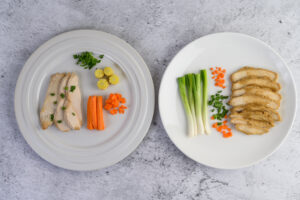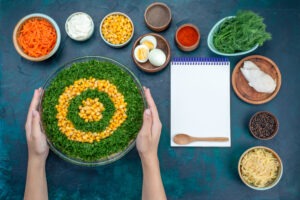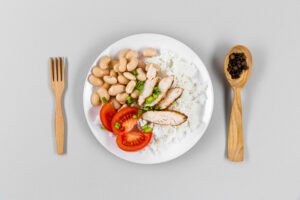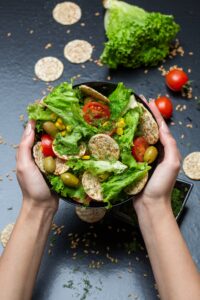Eating healthy doesn’t have to mean giving up the foods you love. In fact, one of the most practical ways to enjoy meals without guilt is to simply balance what’s on your plate. You can still enjoy rice, rotis, dal, and even your favorite sabzis—just in the right portions. That’s the magic of the balanced plate.
Too often, we chase after diets that are either too restrictive or too complicated. But the truth is, healthy eating doesn’t need to be extreme. You don’t need to starve or count every calorie. Instead, think about what your plate looks like. That’s where real change begins—visually, simply, and sustainably.
If you’ve ever felt confused by conflicting nutrition advice, this is your sign to take a step back. Let’s clear the clutter and explore what a truly balanced plate looks like—so you can eat smarter, feel stronger, and live better.
Table of Contents
ToggleIntroduction: Why the Balanced Plate Matters
Balanced plate eating is more than a nutrition trend—it’s a lifestyle habit that supports long-term health, energy, and happiness. In a world full of confusing food advice, calorie-counting apps, and fad diets, this simple visual method brings back clarity.
The concept is easy: Fill your plate with the right foods in the right proportions. That’s it. No calculations. No stress. Just clean, balanced eating that your body understands and thrives on.
Let’s explore how to build a balanced plate that fuels your day, keeps you full, and supports real well-being.
What Is a Balanced Plate?
A balanced plate or balanced diet is a visual model for creating a nutritious, complete meal. It breaks down your plate into three core sections:
- 50% vegetables and fruits.
- 25% lean proteins.
- 25% whole grains or complex carbs.
- + A small amount of healthy fats.
The idea comes from years of nutritional research, including models like Harvard’s Healthy Eating Plate and global dietary guidelines. It works because it helps your body get the ideal mix of fiber, protein, good fats, and slow-burning carbs.
You don’t need to count grams. Just follow the structure.
The Power of Vegetables: Half Your Plate
Balanced plate with vegetables starts by making half of your meal colorful, plant-based, and nutrient-packed. Non-starchy vegetables are low in calories but incredibly rich in vitamins, minerals, and disease-fighting antioxidants.
They also add volume to your plate without overloading it with calories—so you feel full, satisfied, and energized.
Great Non-Starchy Vegetables
- Leafy greens (spinach, kale, arugula, lettuce).
- Broccoli, cauliflower, Brussels sprouts.
- Carrots, beets, radish.
- Bell peppers, cucumber, mushrooms.
- Zucchini, green beans, celery.
Eat them raw, steamed, roasted, sautéed, or grilled. The more variety and color, the better.

Fruits: The Natural Sweetness You Need
Fruits are often paired with vegetables on the balanced plate to make up the 50% plant-based portion. They provide natural sugars (in moderation), fiber, and essential vitamins like vitamin C and potassium.
Go for whole fruits over juices or dried options whenever possible.
Healthy Fruit Picks
- Berries (blueberries, strawberries, raspberries).
- Bananas, apples, oranges.
- Papaya, watermelon, melon.
- Pomegranate, kiwi, apricots.
Just remember, fruit juice—even fresh—counts as only one portion a day. It’s concentrated and lacks fiber.
Quarter of the Plate: Lean Proteins for Strength
Balanced plate with lean protein supports muscle repair, satiety, and metabolic health. Protein keeps you fuller for longer, stabilizes blood sugar, and is essential for every cell in your body.
Try to include different protein sources—animal-based and plant-based—to benefit from a broad spectrum of nutrients.
Protein-Rich Foods to Include
- Eggs, chicken breast, turkey.
- Fish like salmon, sardines, mackerel (rich in omega-3).
- Beans, chickpeas, lentils.
- Tofu, tempeh, seitan.
- Low-fat dairy (Greek yogurt, cottage cheese).
- Nuts and seeds (small portions).
Avoid processed meats like bacon, sausages, and deli cuts as they can increase health risks.
The Other Quarter: Complex Carbs to Fuel Your Body
Not all carbs are created equal. On a balanced plate, carbs come from whole, unprocessed sources that digest slowly and give your body long-lasting energy.
Carbs are your brain’s preferred fuel source. They also support digestion and hormone health—when they come from the right sources.
Smart Carb Choices
- Brown rice, wild rice, quinoa.
- Sweet potatoes, pumpkins, squashes.
- Oats, barley, millet.
- Whole wheat roti, bread, or pasta.
- Legumes (double as protein + carbs).
Limit refined grains (white bread, white rice), sugary breakfast cereals, and fried snacks.
Add Healthy Fats (In Moderation)
A balanced plate isn’t afraid of fats—just the right kind. Healthy fats support your heart, brain, hormones, and keep you feeling full after meals.
But fats are calorie-dense, so the portion should be small—a spoonful, a handful, or a slice.
Healthy Fat Sources
- Avocados.
- Olive oil, sesame oil (cold-pressed, not refined).
- Nuts (almonds, walnuts, cashews).
- Seeds (chia, flax, sunflower).
- Natural peanut butter or almond butter.
Avoid trans fats and partially hydrogenated oils found in packaged and fried foods. These fats are harmful and best left out of your meals entirely.
Hydration: The Hidden Hero of a Balanced Meal
Water doesn’t go on your plate, but it’s a vital part of healthy eating. Staying hydrated improves digestion, concentration, and overall energy levels.
Often, we mistake thirst for hunger. Drinking enough water can even prevent unnecessary snacking.
Hydration Tips
- Drink at least 6–8 glasses of water a day.
- Add lemon, mint, or cucumber to boost flavor.
- Limit sweetened drinks, soda, energy drinks, and packaged juices.
- Unsweetened tea and black coffee are acceptable in moderation.
Start each meal with a glass of water—it sets the tone for mindful eating.
Sample Balanced Plate Meal Ideas
Creating a balanced plate can work with any cuisine. It’s flexible, adaptable, and doesn’t require expensive ingredients.

Indian-Style Meal
- ½ plate: sautéed spinach, carrots, and beans.
- ¼ plate: grilled paneer or dal.
- ¼ plate: brown rice or jowar roti.
- A spoon of ghee or mustard oil.
Asian-Inspired Meal
- ½ plate: stir-fried bok choy, mushrooms, and bell peppers.
- ¼ plate: tofu or baked fish.
- ¼ plate: brown rice or soba noodles.
- Drizzle of sesame oil.
Western Plate
- ½ plate: mixed green salad with tomatoes and cucumber.
- ¼ plate: grilled chicken or boiled eggs.
- ¼ plate: roasted sweet potatoes or whole grain bread.
- Topped with avocado slices or olive oil.
Portion Control: How Much Is Enough?
Portion size is just as important as what goes on your balanced plate. Overeating even healthy food can lead to excess calorie intake and weight gain.
Use your hands as a portion guide:
- Protein: Palm-sized portion.
- Carbs: Fist-sized portion.
- Veggies: Two cupped hands.
- Fats: Thumb-sized portion (for oils/nuts).
This approach works well when eating at home or dining out—no need for weighing scales.
The Benefits of Balanced Plate Eating
Benefits of Balanced Plate
Balanced plate eating brings several powerful benefits:
- More Energy: Avoid highs and lows by keeping blood sugar stable.
- Weight Management: Naturally controls hunger and prevents overeating.
- Better Digestion: High fiber from veggies and whole grains supports gut health.
- Long-Term Wellness: Reduces risks of heart disease, type 2 diabetes, and obesity.
- Sustainable Habit: Easy to maintain—no diet culture or guilt.

Common Mistakes to Watch Out For
Even with the best intentions, some mistakes can sabotage your balanced plate.
- Overloading on carbs (especially refined).
- Using too much oil or butter.
- Skipping vegetables.
- Drinking calories (like sugary sodas or juices).
- Eating too fast or distracted.
Be intentional. Check your plate before you eat. Ask, “Is this balanced?”
Tips for Creating Balanced Plates Every Day
- Plan ahead—prep grains, chop veggies, boil eggs in advance.
- Use compartment plates or lunch boxes—makes portioning easier.
- Eat mindfully—sit down, chew slowly, enjoy your food.
- Add herbs and spices—they add flavor without extra calories.
- Stay flexible—balance doesn’t mean perfection. It means progress.
Kids and Balanced Plates
The balanced plate model works great for kids too! Introduce colorful foods, involve them in meal prep, and make it fun.
Serve mini-portions of everything. Let them explore textures and tastes. Balanced eating becomes a lifelong habit when it starts young.
Balanced Plate vs. Fad Diets
Fad diets often restrict entire food groups, create guilt around eating, and push unrealistic rules. The balanced plate, on the other hand, offers freedom, variety, and enjoyment.
You don’t have to avoid carbs or fear fats. You just need to balance them with the right portions.
This isn’t a short-term fix. It’s a lifestyle you can follow for life.

Final Note: Make Every Plate Count
The balanced plate is more than a nutrition tool—it’s a daily reminder that your health is in your hands. You don’t need fancy superfoods or exotic diets. Just good, honest, real food in the right balance.
One meal at a time, one plate at a time—you’re building the foundation of your wellness.
So next time you sit down to eat, pause for a moment. Look at your plate. Ask yourself: “Is this balanced?”
If yes, you’re already on the path to a healthier, more energetic life.
Call-to-Action
Want more clean eating tips, healthy food facts, and smart nutrition advice? Explore the Food & Nutrition section on Healthy Gen Code (HGC) for practical, fact-based guidance designed to help you live better—one bite at a time. Contact us here & help us grow with kindness.
Balanced Plate – Frequently Asked Questions
1. What is a balanced plate?
A balanced plate is a simple way to plan meals using correct proportions of food groups: 50% vegetables/fruits, 25% lean protein, 25% whole grains or complex carbs, plus a small portion of healthy fats.
2. Why is the balanced plate important?
It provides your body with the right mix of nutrients—fiber, protein, carbs, and fats—for better energy, digestion, immunity, and overall health.
3. Do I need to count calories with a balanced plate?
No. The balanced plate is portion-based, not calorie-based. It focuses on quality and quantity without the stress of counting numbers.
4. Can I follow this if I’m vegetarian or vegan?
Yes! You can use plant-based proteins like beans, lentils, tofu, tempeh, nuts, and seeds to create your balanced meals.
5. Are carbs allowed on a balanced plate?
Absolutely. Carbs are essential. Choose complex carbs like brown rice, oats, quinoa, sweet potatoes, and whole wheat products.
6. How do I measure portions without weighing food?
Use your hand:
- your palm = protein,
- your fist = carbs,
- two cupped hands = veggies,
- thumb = healthy fats.
7. Is fruit required at every meal?
Not always, but it’s a good idea to include a fruit or two daily. They provide natural sugars, vitamins, and fiber.
8. What counts as a non-starchy vegetable?
Spinach, carrots, cucumbers, tomatoes, bell peppers, cauliflower, and similar veggies. They’re low in carbs and high in nutrients.
9. Can I eat Indian food using the balanced plate method?
Definitely. Combine sabzi, dal, roti or rice, salad, and a small serving of curd or ghee to balance your meal.
10. What if I don’t eat 3 meals a day?
No problem. Just try to follow the balanced plate portions whenever you do eat, even for snacks or light meals.
11. How much fat should I add?
Keep it small—like a spoon of olive oil, a few almonds, or a slice of avocado. Enough for nutrition, not excess.
12. Is dairy part of the balanced plate?
Yes, in moderation. Yogurt, paneer, or milk can be part of your protein or fat intake depending on what you choose.
13. Can I have dessert?
Yes—but treat it as an occasional indulgence, not a daily essential. Enjoy mindfully and balance it out with healthy meals.
14. Will this help with weight loss?
Yes, naturally. Balanced eating reduces overeating, keeps you full, and improves metabolism without strict dieting.
15. What about hydration?
Water is essential. Aim for 6–8 glasses daily. It supports digestion, energy, and helps control appetite.
16. Can I use oils while cooking?
Yes. Choose healthy oils like olive, mustard, or groundnut oil—but use them in moderation.
17. Is it okay to eat rice?
Yes. Choose brown or hand-pounded rice, and eat it as one-quarter of your plate—not the whole plate.
18. Can kids follow this too?
Yes, with adjusted portion sizes. Teach them the visual idea of plate portions early—it becomes a healthy habit.
19. Do I need supplements if I eat a balanced plate?
Not usually, unless you have a deficiency. Balanced eating can cover most of your nutrition needs.
20. Can I eat out and still follow the balanced plate?
Yes. Look at your plate, identify the food groups, and balance as best as you can—skip extras like fries or sweet drinks.
Sources
- https://www.healthhub.sg/live-healthy/plan-your-meals-with-my-healthy-plate
- https://www.nhs.uk/live-well/eat-well/how-to-eat-a-balanced-diet/eating-a-balanced-diet/
- https://www.healthhub.sg/live-healthy/plan-your-meals-with-my-healthy-plate
Referral
- Get off using https://hostinger.in?REFERRALCODE=HGC
- Get off using the link here for buying Premium Web Hosting at Hostingrer https://cart.hostinger.com/pay/de220648-48ab-4d33-9c23-477a6764af14
- Get off using the link here for buying Cloud Startup at Hostingrer https://cart.hostinger.com/pay/fecdf014-ea49-431b-913a-88f30fe1db42

